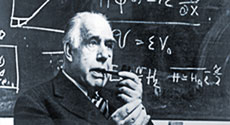Niels Bohr Lecture by professor Henk A. Dijkstra
Physics of El Niño
 The El Niño variability in the equatorial Tropical Pacific is characterized by sea surface temperature anomalies and associated changes in the atmospheric circulation. Through an enormous observational effort over the last decades, the relevant time scales and spatial patterns of El Niño are now well-documented. In the meantime, a hierarchy of models has been developed to understand the physics of this phenomenon and to make predictions of future events. In this presentation an overview will be given of (i) the robust and relevant details of the observations, (ii) the current state of the theory of the El Niño phenomenon and (iii) the forecast skill of models as evaluated after recent El Niño events.
The El Niño variability in the equatorial Tropical Pacific is characterized by sea surface temperature anomalies and associated changes in the atmospheric circulation. Through an enormous observational effort over the last decades, the relevant time scales and spatial patterns of El Niño are now well-documented. In the meantime, a hierarchy of models has been developed to understand the physics of this phenomenon and to make predictions of future events. In this presentation an overview will be given of (i) the robust and relevant details of the observations, (ii) the current state of the theory of the El Niño phenomenon and (iii) the forecast skill of models as evaluated after recent El Niño events.
- AUD. 3 at HCØ, at 15:15, Wednesday, January 11, 2017
As usual, coffee, tea and cookies will be served in front of the auditorium at 15:00.
About Henk A. Dijkstra
Henk A. Dijkstra is professor of Dynamical Oceanography at the Institute for Marine and Atmospheric research Utrecht (IMAU) within the Department of Physics of Utrecht University, The Netherlands. After graduating in applied mathematics at the University of Groningen in 1984, he worked during his PhD (in Groningen) on a Spacelab experiment involving Marangoni convection under microgravity conditions. He continued with this research at the Department of Chemical Engineering at Cornell University during the period 1988-1990. Since 1990 he works at Utrecht University mainly on the stability of the ocean circulation and on the physics of climate variability. He is author of the books “Nonlinear Physical Oceanography” (Springer, 2e edition 2005), “Dynamical Oceanography” (Springer, 2008) and “Nonlinear Climate Dynamics” (Cambridge University Press, 2013). Since 2002, he is a member of the Dutch Royal Academy of Arts and Sciences (KNAW). In 2005, he received the Lewis Fry Richardson medal from the European Geosciences Union and in 2009 he was elected a Fellow of the Society for Industrial and Applied Mathematics
(SIAM).
|
Coffee and Cookies
Coffee, tea and cookies will be served outside the auditorium 15 minutes before the lecture.

 Niels Bohr Lectures
Niels Bohr Lectures